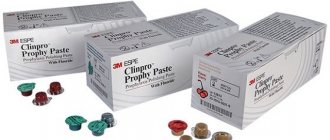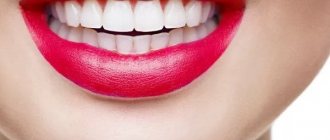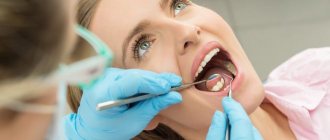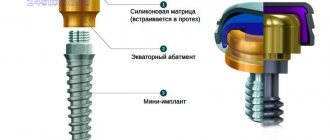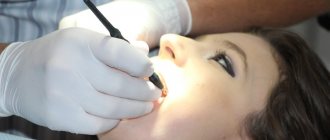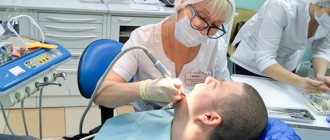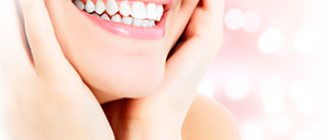What is comprehensive teeth cleaning
Each of us follows basic hygiene rules, including brushing our teeth twice a day. With the help of this simple manipulation, we remove plaque accumulated during the day or night. But the problem is that the interdental spaces and hard-to-reach areas remain uncleaned or not cleaned well enough. As a result, plaque begins to accumulate in these places, and then mineralizes, that is, turns into tartar. It is impossible to remove it with a simple brush and paste. In this case, only professional help from a dentist will help.
The doctor, depending on the type of deposits, may suggest one or another method of cleansing.
The specificity of the instruments used determines the narrow focus of the impact. For example, ultrasonic waves can crush stone, and Air Flow technology can remove soft plaque. Human teeth simultaneously contain both already fossilized and still soft fractions, so for total cleansing it is necessary to use not just one method of professional hygiene, but several procedures in combination. In addition, the enamel layer, having lost its “shell” and has already begun to demineralize underneath, becomes very vulnerable for some time. Therefore, to restore it, it needs recharge, in particular fluorine. Based on the above, we can conclude that only a set of cleaning and protective measures will help your teeth be healthy and beautiful. Comprehensive cleaning includes the following procedures:
- ultrasonic treatment;
- cleansing using Air Flow technology;
- polishing the enamel layer;
- fluoridation.
When is a procedural complex necessary and when it cannot be performed?
Indications for comprehensive cleaning:
- Prevention of caries and periodontal diseases
- Strengthening the enamel layer
- Improving smile aesthetics
- Removing tartar and soft deposits
- Eliminating bad breath
- Before dentures, implantation, installation of braces
- While wearing braces and after removing them
- For crowded teeth
Contraindications:
- Childhood
- Severe cardiovascular diseases
- Presence of a pacemaker
- Difficulty in nasal breathing
- Any disease in the acute period
- Allergy to components of medications used
Carrying out oral hygiene by professionals
The health of the teeth, as well as the body as a whole, depends on personal oral hygiene.
However, if a person neglects scheduled preventive examinations at the dentist, and is also negligent in oral hygiene, the appearance of caries, periodontitis and other unpleasant ailments is guaranteed. You can conduct a preventive examination, complete professional oral hygiene, and also overcome various dental diseases in the city of Shchelkovo, Moscow Region, at the address: Tsentralnaya Street, 80 (near the Voronok railway station) - at the Sanident dental clinic. Our medical institution has many regular clients who are satisfied with the results obtained.
The first stage is ultrasonic treatment
Ultrasound of a certain frequency is capable of coloring tartar into small fragments. Therefore, it is used to remove mineralized deposits on the enamel layer in the supragingival and subgingival zone. This procedure is the first item on a comprehensive list. An ultrasonic scaler destroys stone and, along with it, removes pathogenic microflora in the most inaccessible places of the dentition. Ultrasound is absolutely safe for human health in general and gums in particular. The scaler has an attachment that focuses ultrasound radiation on the area that needs to be treated. The device allows manual adjustment of the intensity of exposure. It is determined by the dentist depending on the conditions of a particular clinical case.
Important: a bonus of using ultrasound is its ability to destroy pathogenic bacteria, i.e., to disinfect the surface being treated. Therefore, dentists strongly recommend performing this procedure for patients with periodontal health problems, not only during a course of treatment, but also regularly to prevent inflammation.
Why should you visit an ART clinic?
ART Dentistry in Odintsovo offers professional oral hygiene - removal of plaque, tartar and prevention of dental diseases. Benefits of visiting the clinic for patients:
- Availability of the best modern equipment in dentistry. The effect on enamel requires a careful approach, without loss of effectiveness. The higher the class of the device used, the better the final result and quality of cleansing. The ART clinic uses devices and materials from well-known world manufacturers, which guarantees the high quality of the services provided.
- All dental services. In the process of oral hygiene, dentists often discover the prerequisites for diseases of the teeth and gums, correctable orthodontic pathologies, and the need for therapeutic treatment. At the ART clinic you can quickly get advice from any specialist (implantologist, orthopedist, orthodontist, dental surgeon) to restore the health and integrity of your teeth and restore the beauty of your smile.
- High level of qualification of doctors. Dentistry employs doctors of the highest, first and second categories with over 5 years of experience. The clinic’s dentists constantly improve their professionalism - undergo training, attend seminars and conferences in the Russian Federation and abroad.
- Affordable price level - the multidisciplinary format of the clinic and the variety of services allow us to maintain a reasonable price level for all services and types of dental treatment.
Second stage – Air Flow
After removing hard contaminants, it is time for deposits with a soft structure. Cleansing is performed using Air Flow technology. Using a special apparatus, a mixture of water, air and tiny grains of soda is applied to the surface of the patient’s teeth. The abrasive size is so small that it can destroy the bacterial film, but cannot leave scratches on the enamel surface. A stream of abrasive mixture directed under pressure destroys pigmented plaque and immediately washes it away. Thanks to this, the enamel is lightened to its natural tone (by about 1 - 2 shades on the Vita scale).
Note: the process is painless, but may cause slight discomfort for people with hypersensitive enamel. In this case, the doctor may suggest local anesthesia. Patients who are allergic to soda should not perform this cleaning.
How often should you do professional dental hygiene?
The recommended interval between professional teeth cleanings in the clinic is six months. However, this period may vary. For example, if you have braces, you may need to visit your hygienist more frequently because plaque builds up faster. At the same time, ultrasonic cleaning in people with orthodontic structures is only possible in the gum area: the braces area is usually treated using Air flow. The frequency of professional hygiene is also influenced by the individual characteristics of the structure of the dental system, as well as the quality of home hygiene. For gum diseases, cleaning dental plaque is one of the first stages of treatment, but this procedure cannot be carried out too often, especially during periods of exacerbation of gingivitis and periodontitis.
Third stage - polishing
Deposits leave microcracks and irregularities on the enamel layer. Therefore, polishing is necessary after cleaning procedures. Otherwise, the remaining roughness will become a “magnet” for microparticles of food, which will very quickly turn into new deposits. Polishing is performed using abrasive pastes and various attachments driven by a drill. These are polishers, brushes, discs, needle-shaped attachments. The interdental areas are polished with special strips. The process does not cause pain and takes about 40 minutes.
How to properly brush your teeth with toothpicks?
Doctors do not recommend frequent use of toothpicks, as they can injure the gums. However, if you don’t have floss on hand, you can carefully use a toothpick, following these recommendations:
- Do not use force when cleaning the interdental space from food particles;
- Do not make sudden movements;
- Try to maintain a 45-degree angle when using a toothpick;
- The direction of movement should be from the gum to the sharp edge of the tooth;
- It is recommended to apply only light pressure so that the toothpick does not break during the process.
The fourth stage - fluoridation
As a rule, fluoridation is not included in the calculation of comprehensive professional hygiene, but it is very important for dental health. The application of fluoride helps strengthen the enamel layer (prevents the leaching of calcium), reduces hypersensitivity, prevents the onset of caries (slows down the proliferation of pathogenic bacteria). Therefore, you should not refuse this procedure. Fluoridation algorithm: the doctor dries the surface to be treated with a warm air stream, then applies fluoride varnish (a harmless composition based on varnish with a high concentration of fluorides) to each element of the dentition, then dries it.
Note: after completing all stages of comprehensive cleansing, teeth become noticeably lighter, reaching their natural natural color. But those patients who dream of a snow-white smile can resort to whitening, for example, using the ZOOM-4 method.
Dentists' tips for caring for your teeth after a comprehensive cleaning
It is in the patient’s interests that the effect of the complex of procedures lasts as long as possible. Therefore, it is important to follow the following recommendations from your dentist in the first few days:
- do not eat or drink for 2 hours after visiting the dentist;
- You should brush your teeth for 3–5 minutes after each meal and at night;
- possible increase in enamel sensitivity. Do not consume food or drinks that are too hot or too cold;
- try not to smoke, tobacco tars eat into the enamel very quickly;
- Reduce (or eliminate) from your diet foods and drinks that contain high amounts of natural and artificial coloring substances.
The dental network offers comprehensive teeth cleaning services. Our clinic offers family and savings discounts. Doctors are highly qualified and improve their skills in leading dental clinics in Russia and Europe. The level of services provided meets international standards.
Branches of our orthodontic center are located in Moscow within walking distance from the metro:
- Art. Alekseevskaya (VDNKh district, etc. Mira), address: st. 3rd Mytishchiskaya house 3, building 2;
- Art. Shelepikha, address: Shelepikhinskaya embankment, address: building 34, building 1.
We will make your teeth strong, beautiful and healthy! Come and see for yourself.
How to brush your teeth? Cleaning Techniques
Proper brushing of teeth includes several stages, each of which is aimed at cleaning one of the surfaces of the teeth, as well as various parts of the oral cavity. For adults, the correct sequence of actions is as follows:
- With your mouth wide open, clean the outer surfaces of your teeth using sweeping movements from the gums to the cutting edge. This must be done with both the upper and lower jaw.
- Do the same on the inside of your teeth. When cleaning your front teeth, turn the head of the toothbrush across the teeth rather than along them.
- Clean the chewing surfaces of your teeth with vigorous horizontal movements.
- To remove plaque and food debris more thoroughly, brush in a circular motion.
- Clean your tongue using the special pad on the back of the toothbrush head or using the bristles itself. You need to move from the root of the tongue forward. Do not press too hard on the root of the tongue, as this may cause vomiting.
- It is recommended to end the evening brushing with a light massage of the gums - to do this, make circular movements with your mouth closed. If you have inflammation or bleeding gums, or enlarged gum pockets, you should avoid this.
- After brushing is completed, the interdental spaces should be cleaned using dental floss. To do this, take a piece of thread 40-50 centimeters long, wrap it around your middle or index fingers and carefully insert it between your teeth, making several movements back and forth. Unwind the floss gradually, cleaning each gap with a fresh section and avoiding putting too much pressure on the gum edge. Flosses are also recommended to be used after each meal to remove food debris from the interdental space.
- The final stage is rinsing your mouth with warm or cold water and washing your brush. For additional protection against unpleasant odors and bacteria, you can use a mouthwash such as ASEPTA Fresh, which contains witch hazel, sage and chamomile extracts that can eliminate inflammation and unpleasant odors.
